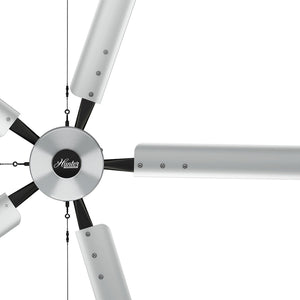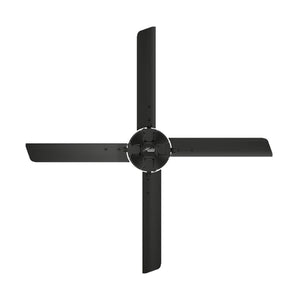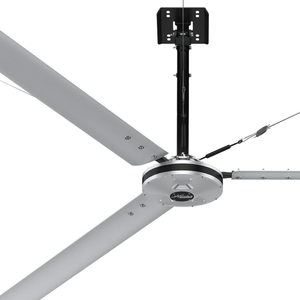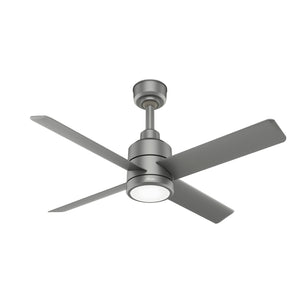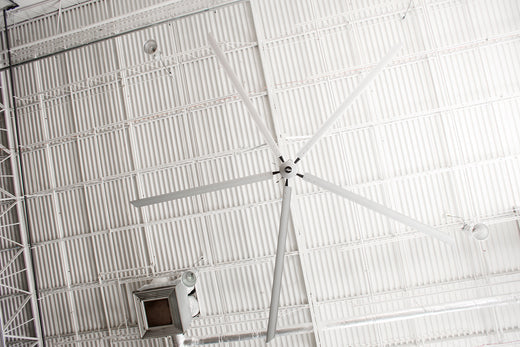Improving Workplace Safety With HVLS Fans

TABLE OF CONTENTS
Importance of Air Circulation Heat Stress Prevention HVLS Fans Safety Benefits FAQsIn warehouses and industrial spaces, worker comfort and safety are a primary concern, and with good reason. A healthy workforce is highly productive, and production is the name of the game in any industry. But with busy operations and large, often overheated spaces, creating the right environment can be a real challenge. That’s where HVLS (High Volume Low Speed) fans come in.
Let's talk about improving workplace safety with HVLS fans. They aren't ordinary ceiling fans. They're built for big jobs, quietly circulating air to keep large areas more comfortable. But the benefits go beyond just that.
HVLS fans help reduce heat stress, which can lead to serious health issues, and they can even lower the chances of heat-related accidents on the job. Plus, they're energy-efficient, making them a smart choice for large facilities trying to balance comfort, safety, and cost.
Can you improve workplace safety with industrial fans? You bet. We're going to show how HVLS fans are having a positive impact on workplace safety, helping to create a more comfortable, safer environment that workers and employers can both appreciate.
Importance of Air Circulation in the Workplace

Good air circulation in the workplace is important for both comfort and safety. HVLS fans excel in this area because they move a lot of air without creating disruptive drafts.
According to Occupational Health & Safety (OHS), destratification fans (like HVLS fans) are excellent at helping cut down on airborne pollutants by circulating the air throughout the space, minimizing concentrations of dust and harmful particles that tend to settle near the floor or in corners.
Enhanced air circulation is particularly beneficial in environments with inadequate natural airflow or less effective HVAC systems. By keeping air moving, HVLS fans also help reduce surface condensation, which minimizes the risk of mold growth – common culprits of indoor air quality (IAQ) problems. Finally, by helping optimize airflow and reducing the need for additional heating and cooling, HVLS fans can improve energy efficiency, thereby lowering energy costs.
Slipping Hazards
Poor airflow in industrial spaces can lead to various hazards that increase the risk of slips and falls. These hazards are often exacerbated in environments with high humidity or inadequate ventilation, creating unsafe working conditions.
- Moisture Accumulation: Poor air circulation allows moisture to build up on floors, making them slippery.
- Condensation Dripping: In humid conditions, condensation can collect and drip from ceilings or equipment, creating wet patches on the floor.
- Dust and Debris Accumulation: Without proper airflow, dust and debris can settle on surfaces, reducing traction and increasing slip risk.
- Fogging: In temperature-controlled areas, fogging can occur on surfaces, obscuring hazards and leading to accidental slips.
- Inconsistent Temperature Control: Variability in temperature can lead to uneven drying of floors after cleaning, creating unexpected slick spots.
Heat Stress Prevention in Warehouses and Other Industrial Environments
Heat stress in warehouses, factories, and other industrial settings is a serious concern, where workers often face high temperatures and humidity. Each year, thousands of U.S. workers suffer from heat-related illnesses due to occupational heat exposure, leading to severe conditions such as heat exhaustion and heat stroke. These health risks can also turn fatal if not addressed promptly.
High temperatures impact worker safety and productivity. When heat stress kicks in, physical and mental performance can decrease, increasing the risk of accidents and injuries – a costly scenario for businesses in terms of lost productivity and medical expenses. Moreover, indoor environments like warehouses, which often lack proper ventilation and climate control, fall into high-risk categories for such stress, especially when the work is physically demanding.
In extreme conditions, such as temperatures reaching 104°F with 80% humidity, worker productivity can plummet, with capacity dropping to as low as 25% – translating to effective work for just 15 minutes per hour. By alleviating these conditions, HVLS fans help protect worker health, maintain workforce efficiency, and reduce economic losses tied to heat stress – which can amount to approximately $100 billion annually in the U.S.
HVLS fans are a powerful ally in combating heat stress. By effectively circulating air throughout a space, these fans help reduce the risk of heat-related illnesses. They work seamlessly with traditional cooling methods like air conditioning by distributing cool air more evenly, thus allowing for better overall air quality and comfort.
HVLS Fans' Safety Benefits
Along with promoting comfort, helping to maintain proper airflow in industrial settings assists in preventing accidents. A HVLS fan's safety benefits include the aid of reduction of moisture buildup, which is a common precursor to slip-and-fall accidents. With slip-and-fall incidents accounting for around 211,640 non-fatal occupational injuries annually, representing 18% of all work-related injuries, the transportation and warehousing sectors are prominently affected. The economic burden of these incidents is staggering, with combined compensation and medical costs reaching approximately $70 billion each year in the U.S.
Beyond slips and falls, HVLS fans help mitigate other safety hazards by allowing for adequate airflow, which assists in preventing machinery and workers from overheating. Poor airflow can lead to machinery malfunction and a heightened risk of heat stress among workers, threatening both safety and productivity.
When compared to other accident prevention measures, HVLS fans stand out for their ability to complement broader safety strategies. Unlike singular solutions, such as non-slip flooring or cooling systems that tackle isolated issues, HVLS fans aid in addressing multiple hazards simultaneously through consistent airflow. They can enhance safety by helping to reduce humidity, which works hand-in-hand with other practices like regular safety audits and equipment maintenance, creating a holistic and safer workplace.
What Is Sick Building Syndrome (SBS)?
Sick building syndrome is a condition recognized by the National Institute of Health (NIH), where building occupants experience negative health effects correlated with time spent in a building. Causes include:

- Biological Contaminants: Microorganisms like viruses, fungi, and bacteria thrive in high-humidity environments.
- Inadequate Ventilation: Poor air circulation leads to the buildup of contaminants and increased exposure to pollutants, leading to poor air quality.
HVLS fans help by dispersing humidity and drying surfaces quickly to reduce microbial growth and slip hazards. Their continuous movement prevents air from becoming stale and helps improve overall air quality.
EXPLORE OTHER CATEGORIES
Conclusion
In the quest for a safer and more efficient workplace, HVLS fans prove to be invaluable allies. By enhancing air circulation, they help maintain better indoor air quality, reduce heat stress, and minimize the risks of accidents such as slips and falls. These fans work quietly and efficiently to help improve the overall environment of industrial spaces, contributing to both safety and comfort.
See Hunter Industrial Ceiling Fans in Action
Explore the outstanding features of Hunter Industrial ceiling fans, engineered to boost comfort and productivity in your facility.
FAQs: Enhancing Workplace Safety With Industrial Fans
Below, we've addressed a few common questions about workplace safety and HVLS fans' role in improving conditions in industrial settings. Please contact us for more information.
HVLS fans are beneficial in industries with large open buildings and high ceilings. Manufacturing plants, warehouses, distribution centers, agricultural facilities, and logistics hubs can see significant improvements in safety and comfort through enhanced air circulation by installing HVLS fans. They help mitigate the risks associated with poor airflow, such as moisture buildup and heat stress, which are common in these high-demand environments.
Absolutely! HVLS fans complement air conditioning systems excellently by circulating air more evenly throughout the space. This helps improve the efficiency of the cooling system but also assists in maintaining a consistent temperature, reducing energy consumption. By optimizing the effectiveness of air conditioning, HVLS fans can contribute to significant energy savings and improved indoor air quality. Just to note, HVLS fans also work in conjunction with heating systems to help enhance air quality.
HVLS fans promote a healthier working environment by allowing for constant air circulation, which helps reduce the presence of airborne pollutants and allergens. This helps mitigate respiratory issues and mitigate heat stress, thereby enhancing workers' overall well-being. The improved airflow also can decrease condensation and mold growth, contributing to a safer environment that supports long-term health.
Hunter Industrial Has Your Solution for Improving Workplace Safety With HVLS Fans
Given their ability to address multiple workplace concerns simultaneously, HVLS fans from Hunter Industrial & Commercial excel as a cost-effective solution for improving workplace safety. They can boost worker well-being by creating a more pleasant workplace atmosphere, help businesses save on energy costs, and reduce the buildup of contaminants associated with workplace incidents. Explore our solutions and begin improving the safety and comfort in your workplace.

 100% Secure Payments
100% Secure Payments